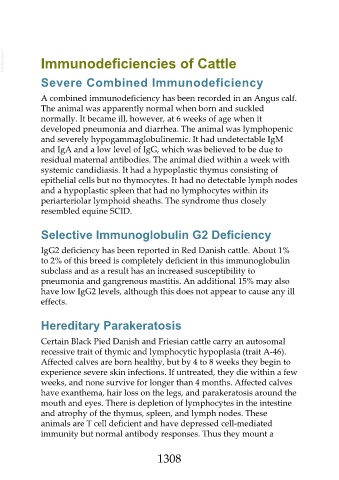Page 1308 - Veterinary Immunology, 10th Edition
P. 1308
VetBooks.ir Immunodeficiencies of Cattle
Severe Combined Immunodeficiency
A combined immunodeficiency has been recorded in an Angus calf.
The animal was apparently normal when born and suckled
normally. It became ill, however, at 6 weeks of age when it
developed pneumonia and diarrhea. The animal was lymphopenic
and severely hypogammaglobulinemic. It had undetectable IgM
and IgA and a low level of IgG, which was believed to be due to
residual maternal antibodies. The animal died within a week with
systemic candidiasis. It had a hypoplastic thymus consisting of
epithelial cells but no thymocytes. It had no detectable lymph nodes
and a hypoplastic spleen that had no lymphocytes within its
periarteriolar lymphoid sheaths. The syndrome thus closely
resembled equine SCID.
Selective Immunoglobulin G2 Deficiency
IgG2 deficiency has been reported in Red Danish cattle. About 1%
to 2% of this breed is completely deficient in this immunoglobulin
subclass and as a result has an increased susceptibility to
pneumonia and gangrenous mastitis. An additional 15% may also
have low IgG2 levels, although this does not appear to cause any ill
effects.
Hereditary Parakeratosis
Certain Black Pied Danish and Friesian cattle carry an autosomal
recessive trait of thymic and lymphocytic hypoplasia (trait A-46).
Affected calves are born healthy, but by 4 to 8 weeks they begin to
experience severe skin infections. If untreated, they die within a few
weeks, and none survive for longer than 4 months. Affected calves
have exanthema, hair loss on the legs, and parakeratosis around the
mouth and eyes. There is depletion of lymphocytes in the intestine
and atrophy of the thymus, spleen, and lymph nodes. These
animals are T cell deficient and have depressed cell-mediated
immunity but normal antibody responses. Thus they mount a
1308

